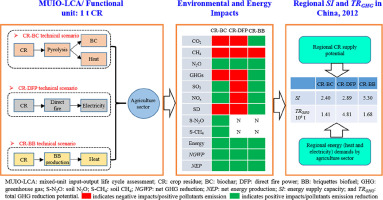当前位置:
X-MOL 学术
›
Sci. Total Environ.
›
论文详情
Our official English website, www.x-mol.net, welcomes your
feedback! (Note: you will need to create a separate account there.)
Comparison of different crop residue-based technologies for their energy production and air pollutant emission.
Science of the Total Environment ( IF 8.2 ) Pub Date : 2019-12-13 , DOI: 10.1016/j.scitotenv.2019.136122 Yanhui Dai 1 , Hao Zheng 2 , Zhixiang Jiang 3 , Baoshan Xing 1
Science of the Total Environment ( IF 8.2 ) Pub Date : 2019-12-13 , DOI: 10.1016/j.scitotenv.2019.136122 Yanhui Dai 1 , Hao Zheng 2 , Zhixiang Jiang 3 , Baoshan Xing 1
Affiliation

|
Crop residue (CR) based-technology has several benefits, including renewable energy production and improvement in the environment and waste biomass management. However, the quantitative assessment of different CR based-technologies in terms of these benefits is limited. In this study, three typical CR-based technologies, CR biochar (CR-BC), CR direct-fired power (CR-DFP), and CR briquette biofuel (CR-BB), were assessed in terms of energy- and environment-related performances using a mixed-unit input-output life cycle assessment method. The results indicated that CR-BB performed better in energy production and air pollution mitigation than the other two technologies. Energy conversion efficiency was suggested as a key factor in determining the potentials of bioenergy production and environmental improvement. Furthermore, based on the energy demand from the Chinese agricultural sector and CR supply in 2012, the energy supply capacity (ESI) of CR-BC, CR-DFP, and CR-BB was estimated to be 24.3, 2.89, and 53.0, respectively, and their total greenhouse gas (GHG) reduction potential (TRGHG) was estimated to be 1.41 × 106, 4.81 × 106, and 1.68 × 106 t CO2e (CO2 equivalent), respectively. Overall, the CR-DFP and CR-BC are recommended for the high-value utilization of CR resources. The findings of this study could provide a basis for the development of CR-based technologies and CR management policy.
更新日期:2019-12-17




















































 京公网安备 11010802027423号
京公网安备 11010802027423号